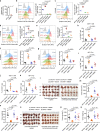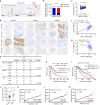Glucocorticoid receptor regulates PD-L1 and MHC-I in pancreatic cancer cells to promote immune evasion and immunotherapy resistance
- PMID: 34873175
- PMCID: PMC8649069
- DOI: 10.1038/s41467-021-27349-7
Glucocorticoid receptor regulates PD-L1 and MHC-I in pancreatic cancer cells to promote immune evasion and immunotherapy resistance
Abstract
Despite unprecedented responses of some cancers to immune checkpoint blockade (ICB) therapies, the application of checkpoint inhibitors in pancreatic cancer has been unsuccessful. Glucocorticoids and glucocorticoid receptor (GR) signaling are long thought to suppress immunity by acting on immune cells. Here we demonstrate a previously undescribed tumor cell-intrinsic role for GR in activating PD-L1 expression and repressing the major histocompatibility complex class I (MHC-I) expression in pancreatic ductal adenocarcinoma (PDAC) cells through transcriptional regulation. In mouse models of PDAC, either tumor cell-specific depletion or pharmacologic inhibition of GR leads to PD-L1 downregulation and MHC-I upregulation in tumor cells, which in turn promotes the infiltration and activity of cytotoxic T cells, enhances anti-tumor immunity, and overcomes resistance to ICB therapy. In patients with PDAC, GR expression correlates with high PD-L1 expression, low MHC-I expression, and poor survival. Our results reveal GR signaling in cancer cells as a tumor-intrinsic mechanism of immunosuppression and suggest that therapeutic targeting of GR is a promising way to sensitize pancreatic cancer to immunotherapy.
© 2021. The Author(s).
Conflict of interest statement
The authors declare no competing interests.
Figures








Similar articles
-
Autophagy promotes immune evasion of pancreatic cancer by degrading MHC-I.Nature. 2020 May;581(7806):100-105. doi: 10.1038/s41586-020-2229-5. Epub 2020 Apr 22. Nature. 2020. PMID: 32376951 Free PMC article.
-
NDRG1 overcomes resistance to immunotherapy of pancreatic ductal adenocarcinoma through inhibiting ATG9A-dependent degradation of MHC-1.Drug Resist Updat. 2024 Mar;73:101040. doi: 10.1016/j.drup.2023.101040. Epub 2024 Jan 9. Drug Resist Updat. 2024. PMID: 38228036
-
Irreversible electroporation combined with PD-L1/IL-6 dual blockade promotes anti-tumor immunity via cDC2/CD4+T cell axis in MHC-I deficient pancreatic cancer.Cancer Lett. 2025 May 1;617:217620. doi: 10.1016/j.canlet.2025.217620. Epub 2025 Mar 9. Cancer Lett. 2025. PMID: 40068706
-
The clinicopathological and prognostic significance of PD-L1 expression in pancreatic cancer: A meta-analysis.Hepatobiliary Pancreat Dis Int. 2018 Apr;17(2):95-100. doi: 10.1016/j.hbpd.2018.03.007. Epub 2018 Mar 13. Hepatobiliary Pancreat Dis Int. 2018. PMID: 29576277 Review.
-
Immunotherapy in pancreatic ductal adenocarcinoma: an emerging entity?Ann Oncol. 2017 Dec 1;28(12):2950-2961. doi: 10.1093/annonc/mdx503. Ann Oncol. 2017. PMID: 28945842 Free PMC article. Review.
Cited by
-
Tumors recycle glucocorticoids to drive Treg-mediated immunosuppression.J Clin Invest. 2023 Sep 15;133(18):e173141. doi: 10.1172/JCI173141. J Clin Invest. 2023. PMID: 37712416 Free PMC article.
-
Targeting PD-1/PD-L1 in cancer immunotherapy: An effective strategy for treatment of triple-negative breast cancer (TNBC) patients.Genes Dis. 2022 Aug 24;10(4):1318-1350. doi: 10.1016/j.gendis.2022.07.024. eCollection 2023 Jul. Genes Dis. 2022. PMID: 37397537 Free PMC article. Review.
-
A single-cell perspective on immunotherapy for pancreatic cancer: from microenvironment analysis to therapeutic strategy innovation.Front Immunol. 2024 Oct 30;15:1454833. doi: 10.3389/fimmu.2024.1454833. eCollection 2024. Front Immunol. 2024. PMID: 39539544 Free PMC article. Review.
-
Melanophilin-induced primary cilia promote pancreatic cancer metastasis.Cell Death Dis. 2025 Jan 16;16(1):22. doi: 10.1038/s41419-025-07344-2. Cell Death Dis. 2025. PMID: 39820281 Free PMC article.
-
High tumor glucocorticoid receptor expression in early-stage, triple-negative breast cancer is associated with increased T-regulatory cell infiltration.Breast Cancer Res Treat. 2025 Feb;209(3):563-572. doi: 10.1007/s10549-024-07515-3. Epub 2024 Nov 23. Breast Cancer Res Treat. 2025. PMID: 39579248 Free PMC article.
References
Publication types
MeSH terms
Substances
Grants and funding
LinkOut - more resources
Full Text Sources
Medical
Research Materials

